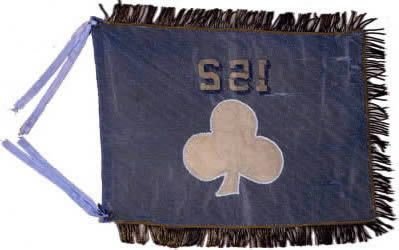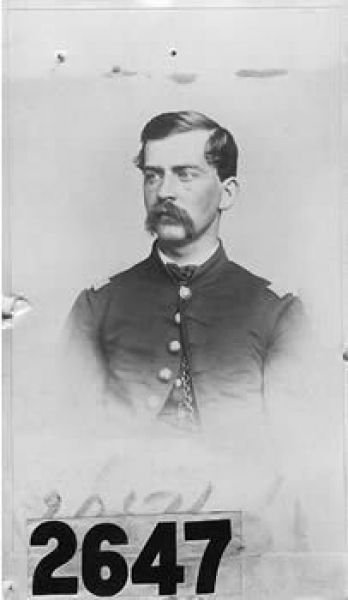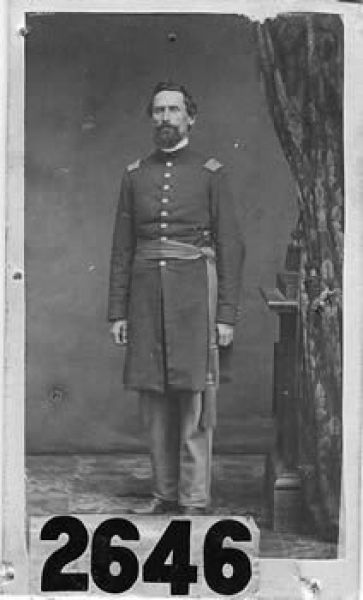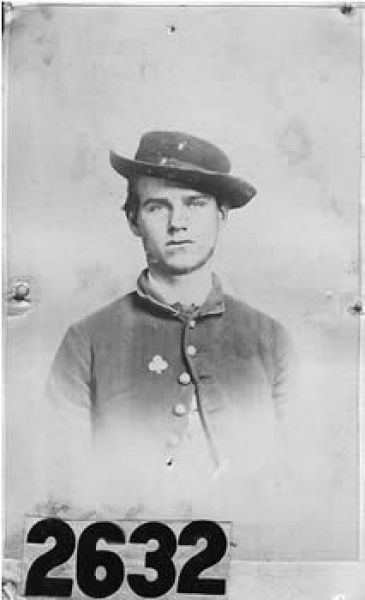Other Resources
This is meant to be a comprehensive list. If, however, you know of a resource that is not listed below, please send an email to ng.ny.nyarng.list.historians@army.mil with the name of the resource and where it is located. This can include photographs, letters, articles and other non-book materials. Also, if you have any materials in your possession that you would like to donate, the museum is always looking for items specific to New York's military heritage. Thank you.
Bailey, W. J. W.J. Bailey reminiscence, 1928.
Reminiscence describing his Civil War experiences and the events of the Custer defeat at the Little Big Horn (1876). Also included is an explanatory letter by Theresa Berglund.
0 .1 linear ft.
Located at the Montana Historical Society.
Doubleday, Theodore N. Civil War Miscellaneous Collection.
(Enlisted man's diary, Jan 1-Aug 11, 1865).
Located at the Military History Institute in Carlisle, PA.
Helen Church Lowry collection of Civil War correspondence, 1858-1895.
Description: .25 cubic feet
Abstract: This accession consists of letters written to Helen Church from several soldiers during the Civil War. The bulk of the letters are from Alonzo Shumway and date from 1861-1864. Shumway's letters primarily describe his travels and experiences as a Captain in the 6th Michigan Infantry. The regiment went first to Maryland, then south where they spent the war in Louisiana. Shumway describes sailing with General Butler's Expedition against New Orleans on the transport "Constitution," living on Ship Island, and the sickness (including his own) the regiment experienced. He also described southern life as he saw it - plantations, starvation, swamps, and "wagons loaded with negroes." Occasionally, Shumway describes battles including the expedition up the Bayou Teche to destroy the Rebel Ironclad Gunboat "Cotton." The collection also contains three letters from Helen's uncle, David Oliphant (1862-1863) and four letters from Julius Townsend (1858-1864). There are letters from three additional men (1860-1863): James J. Brown, E. Lounsbury, and an unidentified author. In addition, there is an 1885 wedding invitation for Helen Dunham Williams and David Oliphant Haynes of Detroit, and two photographs. One (ca 1875) is of Helen and her two sisters, Minnie and Mary, and the other is an 1895 portrait of Helen.
Held by the The Michigan History Foundation.
Horn, John (John Edward) The destruction of the Weldon Railroad, Deep Bottom, Globe Tavern, and Reams Station, August 14-25, 1864 Lynchburg, Va. H.E. Howard, Inc. 1991.
Thank you to Chris Duryea for pointing out the section on the 100th, 152nd and 2nd Artillery.
Howard, H., ed. "From the Trenches at Petersburg: Civil War Letters of George Mereness, 152d N.Y.S.V.I." The Kepi (Feb/Mar l985): pp. 5-6.
Keith, Elijah, et a. Elijah Keith Civil War papers, 1862-1865.
Description: 0.5 cu. ft
Abstract: The Elijah Reed Keith Civil War papers consist of correspondence between Elijah and different members of his family, primarily his wife Caroline, during the years 1862-1865. The first letters dated ca. Feb. 1862, come from Charles Keith, who has already mustered into service in the New York State Volunteers, and are addressed to his father, who had not yet enlisted. Charles' letters are brief updates concerning his whereabouts and living conditions. He writes to his family relatively infrequently up until the time of his death on June 17, 1864. Elijah's letters begin on Sept. 25, 1862, while he is at Camp Schuyler in Herkimer Co., N.Y. He writes to his wife and family at least twice a week throughout his time in the service. Although Elijah does not seem to see much combat because of illness, he remains with his regiment for much of the war, until he goes to the Armory Square Hospital in Washington, D.C. on Feb. 2, 1864. His letters contain vivid descriptions of army life and of the hospital, as well as his opinions on such matters as abolition, the looting of southern homes, and the nature of war. Letters written to Elijah Keith from his wife, Caroline Lake Keith, and occasional letters from daughters, Celia and Laverna, describe life on the family farm, the sale of farm produce, financial troubles, and sentiments about issues such as the draft and the war in general.
Held by the Fenimore Art Museum.
Kellogg, H. J. "Glory hallelujah"--double quick. :Written for the 152d Reg. N.Y.S.V., Camp Schuyler, Herkimer, N.Y. : s.n., 1862. 1 sheet ([1] p.) ; 19 x 16 cm.
Located at the New York Historical Society, New York, NY.
Krutz, David P. Distant Drums: Herkimer County in the War of the Rebellion, Utica: North Country Books, 1997.
Thank you to Steve Glazer for pointing out this resource.
Mabie, Jasper. Letter, 1863 April 17.
Letter to his wife Angeline Mabie. Letterhead depicts Camp Marcy, Va. near Chain Bridge, writes about waiting for orders, slowness of pay, and having his picture taken.
1 item (3 p.) ; 28 cm.
Located at the New York State Library Manuscripts and Special Collections.
McCann, Matthew. Letter, May 1864.
3 leaves.
Letter, 5 and 14 May 1864, from Matthew McCann of Company F, 152nd New York Regiment, to his wife Eliza in Herkimer County, New York, informing her on 5 May that his regiment was moving, and on 14 May describing the battles of the Wilderness and Spotsylvania Court House, stating the number of wounded and killed from his company, and thanking God that he was uninjured. Also includes the letter’s envelope.
Accession 38747. Located at the Library of Virginia in Richmond, Virginia.
Thank you to Ed Worman for pointing out this resource.
McCann, Matthew. Civil War letters of Matthew McCann,1864-1865.
McCann recounts interviews with Confederate deserters (6 p.; 12 Sept. 1864) and a first hand account of the disintegration of General Lee's army in the final days of the war (4 p.; 3 April 1865).
2 items.
Located in the Pearce Civil War Collection, Navarro College, Corsicana, Texas.
Quinby, John W. John W. Quinby diary,1862-1864.
Civil War diary kept by Capt. John W. Quinby of East Bridgewater, Mass. of the 152nd New York Volunteer Infantry, Company F, 24 Aug. 1862- 6 Jan. 1864. Quinby recorded in his pocket diary daily activities; troop locations including Fort Greene, New York, various places in Washington D.C., and Suffolk and Auburn, Va.; guard duty; and his decision to resign from the army in 1863. Also includes addresses, most likely of men Quinby served with; and some of his account balances.
1 v. in a folder.
Located at the Massachusetts Historical Society.
Radley, Stephen. Letter (April 16, 1864).
1 item.
Letter sent to Radley's father regarding the amount of army pay to be sent home.
Located at the New York State Library Manuscripts and Special Collections.
Roback, Henry. The veteran volunteers of Herkimer and Otsego counties in the war of the rebellion being a history of the 152nd N. Y. V. With scenes, incidents, etc., which occured in the ranks, of the 34th N. Y.,97th N. Y., 121st N. Y.,2d N. Y. heavy artillery, and 1st and 2d N. Y. mounted rifles;also the active part performed by the boys in blue who were associated with the 152d N. Y. V. in Gen. Hancock's Second army corps during Grant's campaign, from the Wilderness to the surrender of Gen. Lee at Appomattox Court House, Va. Utica, N.Y.,: Press of L.C. Childs & son, 1888.
Sisson, Albert E. Francis Marion Sisson, Jacob Gould, and Orin Gould in the American Civil War. 2015.
Smith, Douglas Edward. The Smith family : descendants of the New York frontier & volunteers during the Revolutionary War : Hesse-Hanau Artillery, Tryon County Miitia : War for the Union, 24th NY Cavalry Volunteers, 152nd Regiment of NY Volunteers : World War II, United States Navy Reserve CB's. [Altamont, N.Y.] : [Douglas E. Smith], 1996.
White, Lori. "Not a man, nor patriot, nor a christian that will shrink from duty" : the Elijah Keith Civil War papers, 1862-1865. S.l. : s.n., 2007.
The Keith family of Milford, New York, exchanged over three hundred letters during the course of the Civil War. The Elijah Keith Civil War papers include the correspondence of two family members who served in the Union Army, and in most cases the letters of both the sender and recipients have survived. Utilizing the letters' contents, regimental histories, government reports, and secondary histories, my thesis considers the war's impact and meaning to the entire family and focuses in particular on Elijah Keith. A minister, father, and farmer, Elijah followed his son Charles into the army and enlisted in the 152nd Regiment of the New York State Volunteers (N.Y.S.V.). He left a myriad of responsibilities behind, but believed his enlistment fulfilled obligations every Christian owed their God and country. Keith pursued duty, as defined by northern Protestantism and the reigning political culture of the North, into war and believed the expansive threat of slavery made his sacrifice necessary. Poor health and other circumstances prevented him from ever participating in battle, but his experiences are unique and varied. From upstate New York he traveled to Virginia, performed guard duty in New York City at the close of the 1863 draft riots, and witnessed the war's human cost in two different military hospitals. Elijah speaks eloquently about all these topics and documents how the realities of military service challenged his beliefs. Elijah struggled with loneliness, illness, desertion, his family's patriotic indiscretions, and Charles' death in battle. His faith in God and country prepared him for disappointments, however, and provided a language to explain the hardships he faced. Despite the emotional and physical pain the war caused, Elijah believed it was fought for God's purposes -- to preserve the United States and its values from slavery. Experience shed away his idealism, but Elijah remained faithful to the religious and political values that defined his life and relationships. iv., 62 l. : ill. ; 29 cm.
Unit bibliography from the Army Heritage Center
Items in the museum collection are in bold.





